Ralph Ramos on Getting In Shape for Elk Season

Editor’s Note: Ralph Ramos from Las Cruces, New Mexico, who has been wearing Mossy Oak for 25 years, has been a member of the Mossy Oak ProStaff for the last 8 years. An elk guide, Ramos teaches a different form of elk calling - aggressive calling that’s had proven success. This week we’ll learn how to get ready for elk season, and why Ramos calls the way he calls.
To be successful at elk hunting, you almost have to be physically fit. I ask the people I'll be hunting with during elk season to get physicals from their doctors. To get ready for elk season, I like to ride my bicycle - generally about 5 miles every day - and then build-up to being able to ride 9 miles just before elk season begins. I like varying terrain and ride my bike up mountains as well as on flats. One of the main reasons I ride a bike to prepare for elk season is to get my cardio system as healthy and strong as possible. I also do some lightweight lifting, to get strong and limber and add another degree of conditioning that you need for hunting elk.
Also in the early summer, I start fine tuning all my elk calls. I rely heavily on my different elk calls to force bulls to bugle, and I carry a wide range of elk calls. The technique I use is what I call excessive cow and bull calling, and I'm also a strong believer in rattling. My rattling antlers are two 5x5 sheds that I oil down each year with linseed oil to help them sound like real bull elk antlers clashing together rather than sounding like dropped antlers. Rattling, a relatively new technique for the elk hunter, is something I've been playing around with for about 10 years now. In the last 5 years, I feel like I've really learned how to use rattling antlers much more successfully for calling in bull elk. I crash the antlers together, and I rake them up and down trees. I now use antlers for elk hunting from September 1 all the way into the late season in mid-October. The peak rut in New Mexico is usually right around the end of September, and the rut starts going downhill about the middle of October. Rattling works all the way through the season. I also have fresh reeds in all my calls, because when I put a call in my mouth, I want to know I can produce the sound exactly the way I want it to be.
 Muffling my bugle tubes is another technique I'm using. I put soft foam inside my bugle tubes and tie a string onto the end of the foam. Then I can pull the foam out to whatever length I want it to be and get a different sound out of my bugle. The chamber where the sound resonates doesn’t make the call sound like it’s coming from a plastic call when there’s foam in it. Plus, with that foam in my bugle, my bugle sounds completely different from everyone else’s. I feel like I get a more-nasal sound by having that foam in my bugle tubes. When I've been hunting on public land and heard a bugle, I can tell the difference in an elk bugle and a manufactured call. I almost can tell you what manufacturer has produced that bugle, since different calls made by various call companies produce specific sounds. That’s why I started experimenting with foam to change the sounds of my calls. My calls don’t sound as tinny (plastic) or in a higher register as other hunters’ calls do. The foam also muffles the chuckles and grunts to make them much deeper and guttural sounding.
Muffling my bugle tubes is another technique I'm using. I put soft foam inside my bugle tubes and tie a string onto the end of the foam. Then I can pull the foam out to whatever length I want it to be and get a different sound out of my bugle. The chamber where the sound resonates doesn’t make the call sound like it’s coming from a plastic call when there’s foam in it. Plus, with that foam in my bugle, my bugle sounds completely different from everyone else’s. I feel like I get a more-nasal sound by having that foam in my bugle tubes. When I've been hunting on public land and heard a bugle, I can tell the difference in an elk bugle and a manufactured call. I almost can tell you what manufacturer has produced that bugle, since different calls made by various call companies produce specific sounds. That’s why I started experimenting with foam to change the sounds of my calls. My calls don’t sound as tinny (plastic) or in a higher register as other hunters’ calls do. The foam also muffles the chuckles and grunts to make them much deeper and guttural sounding.
When I'm using my rattling antlers - raking them against trees or hitting them together - I like to have my bugle tube in my mouth and give a numbers of groans, chuckles and moans. This practice gives a more-realistic sound. If I can get a bull to start chuckling back to my calls, he’ll usually bugle back to me - even in the early season. Once a bull bugles back to me, I get aggressive with raking trees with the antlers and clashing them together. I want to make that bull so curious that he has to come in and see what’s happening. During the early season, I really get aggressive with my calling to stimulate the bull more than calling occasionally will. Even when I'm walking a ridge, I’ll call a little bit just to see if I can get a bull to answer me. But if I find a saddle in a mountain with a lot of droppings and elk tracks, this is where I’ll set-up and go through a longer calling sequence. I’ll rattle and call for 15 to 20 minutes and then move to another setup site.
I have a Facebook page titled Ramos Hunts and Video Productions. Go there and see some of my videos and photos of the elk we harvest every year. You can contact me at 575-642-3219, and I’ll make recommendations about where you can put in to possibly get tags.
Tomorrow: Ralph Ramos Uses Excess Cow Calling to Trigger Bull Elk to Bugle



























